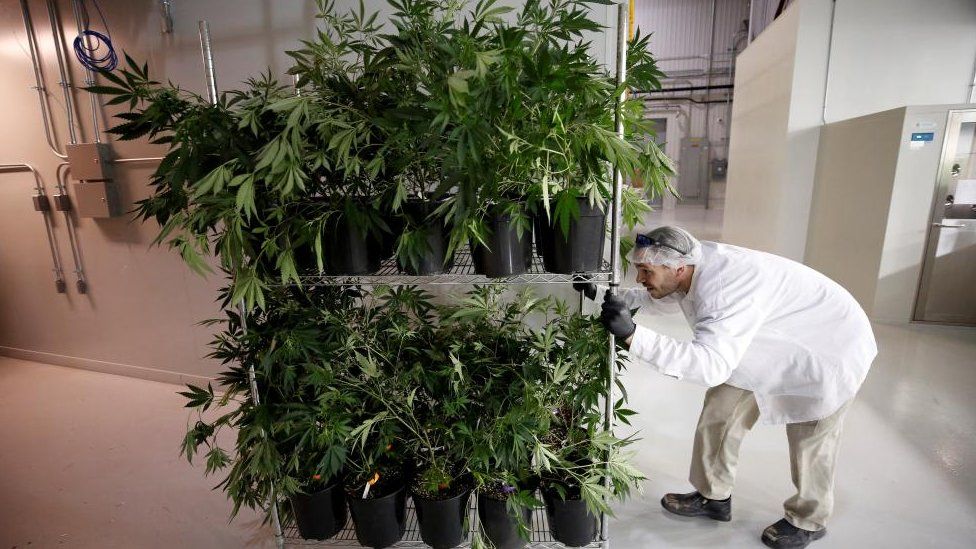ARTICLE AD BOX
 Image source, Reuters
Image source, Reuters
Canopy Growth's Smiths Falls, Ontario, multi-million dollar headquarters has been sold as it struggles with financial losses
By Nadine Yousif
BBC News, Toronto
Canada remains one of the only countries in the world that allows legal and regulated access to recreational marijuana. But five years after the drug's legalisation, the country's cannabis industry is struggling for survival.
George Smitherman remembers buying his first legal gram of cannabis in October 2018 from a Tweed shop in Newfoundland.
The cannabis company had made headlines two years prior for signing a marketing deal with US rapper Snoop Dogg, which was hailed at the time as a sign of a new dawn in the marijuana industry.
The shop,Mr Smitherman recalls, was "beautiful".
"I didn't know if I was in a spa or a jewellery showroom," he said.
He also remembers the juxtaposition of the product he bought versus the striking space he bought it in - all marijuana products in Canada are sold in generic packaging with plain, government-issued labels.
Still, it was an exciting time, Mr Smitherman recalls. Canada's long-anticipated cannabis legalisation had just become a reality. Investment was flowing into a brand new market that many thought would get them rich.
Five years later, the industry is dealing with economic struggles far removed from the enthusiasm of those early days.
Take Aurora Cannabis, for example. The Alberta-based cannabis manufacturer - one of the largest in Canada - announced in August that it will be diversifying its offerings and start selling orchids.
Both companies, along with other cannabis producers, have also given out pink slips to thousands of workers in an effort to cut costs as they continue to generate little to no profit.
Part of the problem, experts and industry leaders say, is overregulation of the drug as the country attempts to tow a careful line between public health and building a robust cannabis industry.
Others say it's simply a matter of too many players and too much production that far exceeds demand.
And because Canada is one of the only countries in the world that federally allow the manufacturing and consumption of recreational cannabis, the options for domestic producers to make money outside Canada's borders remain very limited.
Image source, Getty Images
Image caption,Marijuana in Canada is sold in government-issued packaging, and advertising of cannabis products is not allowed
These challenges were difficult to see early on, said Mr Smitherman, a former Ontario politician who is now the head of the Cannabis Council of Canada.
"The thing is, there was no global road map," he told the BBC, as no other country had attempted to legalise recreational cannabis on such a large scale.
When Canada passed its landmark Cannabis Act in 2018, one of its biggest goals was to move marijuana users away from the illicit market towards a legal, regulated market. It was designed to keep the drug away from minors and limit money flowing into the illegal marijuana trade.
There was also the economic argument as well - that Canadians and the country's economy as a whole would stand to benefit.
In many ways, that economic equation still holds true: Canada's domestic recreational market is valued in the billions. In 2022, Deloitte Canada estimated that cannabis added C$43.5bn ($31.91bn; £26.23bn) to the country's gross domestic product since legalisation.
And Canadians can access legal and regulated marijuana just about anywhere in the country.
Michael Armstrong, a cannabis business researcher at Brock University in Ontario, argues that early hiccups paved the way for some of the business challenges seen today.
"One way to sum it up would be to say we've kind of had a classic boom and bust," Prof Armstrong said.
In the early days, many stores were dealing with chronically empty shelves as production could not keep up with demand. Prof Armstrong said this drove cannabis producers to make too much product, which led to a surplus and an eventual downsizing.
It also meant that many still relied on the illicit market to get their marijuana.
On the retail side, cannabis stores were initially very profitable. But a clustering of storefronts over time in the same areas meant retailers had to lower their prices and offer other incentives to compete with other stores nearby.
As of 2023, there are around 3,600 licensed retail cannabis stores across the country and 970 licensed cannabis producers in Canada.
Few of those producers appear to be profitable. Mr Smitherman said a recent survey by the Cannabis Council of Canada found that only 20% are showing some form of positive cashflow.
"The attrition, turnover and consolidation is relentless," he said of the current business landscape.
Image source, Toronto Star via Getty Images
Image caption,In Toronto, concerns have been raised about an oversaturated retail market
Some also point the finger at what they say is the overregulation of the industry, where cannabis is still a controlled substance. By law, cannabis companies cannot advertise their products or build brand recognition in the way companies in other industries can.
Retail locations have tinted windows to conceal what is inside, and the drug is sold in government-approved packaging. They also pay higher regulatory fees than companies selling other controlled substances.
It is part of a delicate balance the government has tried to strike between public health and managing a new legal industry, Prof Armstrong said.
"The big trade off in legal cannabis is: how do you make the legal market attractive enough to get all the existing users to go with the legal weed, but not so attractive that you get a whole bunch of new users starting up," he said.
Canada also has stringent laws on the types of products that can be sold, as well as their potency. Some argue that this has caused illegal cannabis in the country to continue to thrive even under legalisation.
Consumers of cannabis edibles, for example, are able to go online and find products with a potency higher than the legal amount, Mr Smitherman said.
Often, those products are sold at a considerably lower cost than what is being offered in licensed stores.
In late 2022, Canada's Department of Public Safety estimated that 33% of the marijuana market is still controlled by the illicit drug trade.
There are also limited options for Canada's cannabis producers to profit outside of the country's borders.
Canada remains the only country with a legal, federal cannabis framework outside of Uruguay, and the export of recreational products is not allowed.
While some states in the US have legalised marijuana, the drug remains illegal at the federal level.
Countries in the European Union have toyed with the idea of legalisation, but "they are moving very slowly", Prof Armstrong said, partly due to stringent EU laws.
Industry leaders like Mr Smitherman have long lobbied the government for looser laws that, he argues, will benefit the cannabis industry while not straying away from the country's public health objectives.
"Our argument is: 'Hey, if we can make some incremental changes here, collectively, we can grow the pie,'" he said.
Despite the challenges, many still hail legalisation as somewhat of a success.
"From a public policy standpoint, the people of Canada are very satisfied with it," Mr Smitherman said.
"But one of the measures of success is, are we creating a sustainable model here where, in the next five years, we are going to see good cannabis companies bringing innovative products and winning that battle for market share, or are we going to retreat?"
Prof Armstrong said that what Canada has is "what no other country in the world has".
"Now, having said that, legalisation is not a roaring success."

 1 year ago
25
1 year ago
25








 English (US) ·
English (US) ·